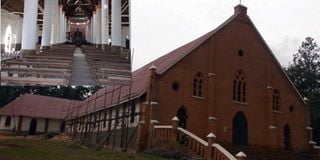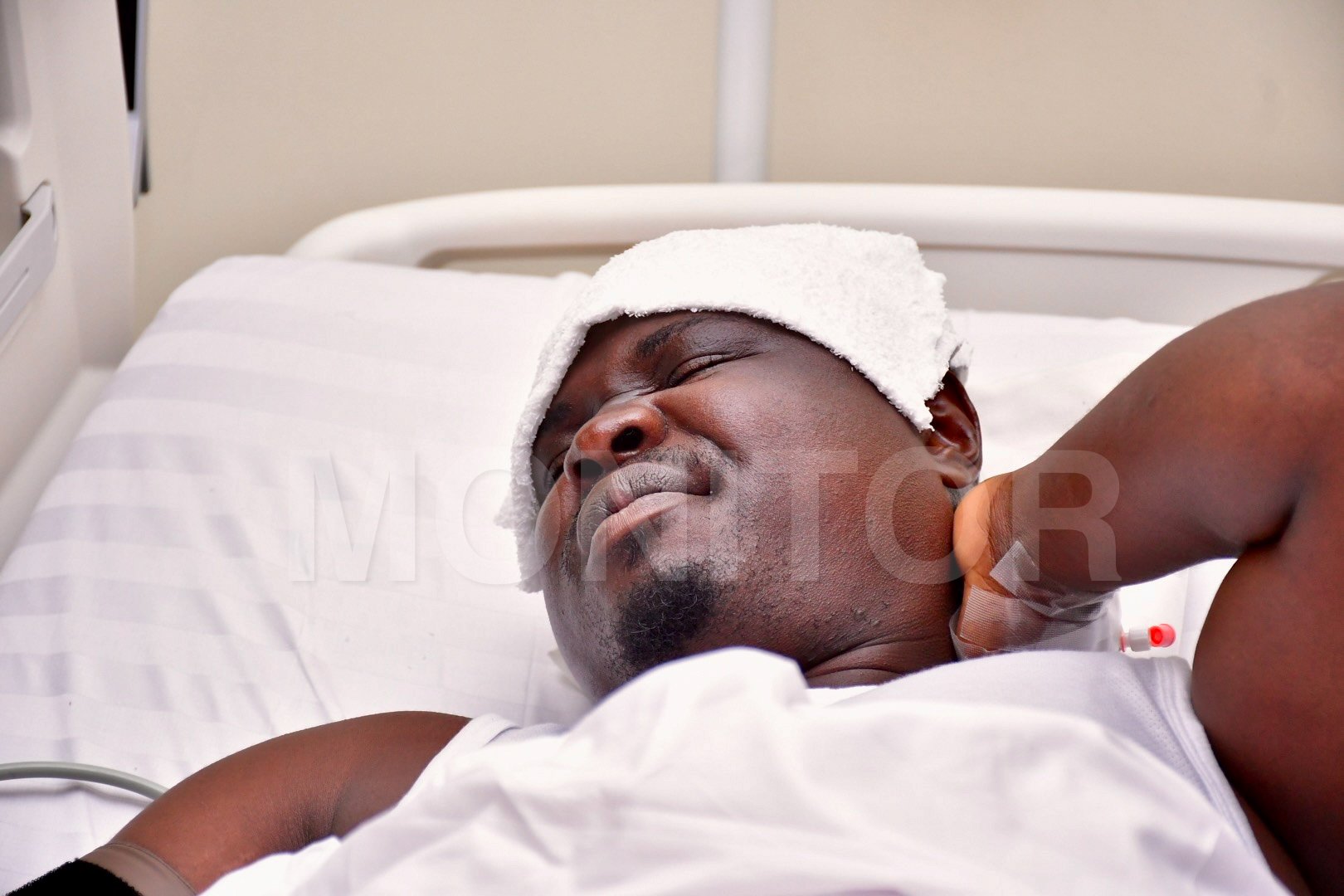Prime
Villa Maria church: The home to first African Catholic priests

Villa Maria Cathedral in Masaka under renovation. The cathedral is one of the oldest brick buildings in the country and it appears set to last hundreds of years more. Inside the historic Villa Maria Cathedral (Inset).Photos by Michael J Ssali.
What you need to know:
As Uganda awaits the papal visit, we trace some of the churches that are key to the Catholic faith in Uganda.
Villa Maria Cathedral is as large as half a football pitch. It is one of the oldest brick buildings in the country and it appears set to last hundreds of years. When Saturday Monitor visited the church recently, it was undergoing renovation and the masons who were struggling to remove an old window for replacement were awed by the great strength of a wall two feet thick, built more than 100 years ago with mud and unbaked clay bricks. Until the early 1930s, the cathedral was grass-thatched and up to this day, the reeds that supported the grass-thatch are still part of the roof. It is over the reeds that iron sheets painted with red oxide were laid.
The beginning
Today, Villa Maria is just a Catholic parish in Masaka Diocese, but more than 100 years ago, it was the administrative seat of a vicariate that extended as far as Ankole, Bunyoro and some parts of Tanzania, according to Rev Fr Anthony Kakumba Mwanje, the parish priest.
Villa Maria’s beginning is linked to the story of a French missionary priest, Fr Henry Streicher, who arrived there on March 19, 1891, and formally set up the parish in 1892, before being consecrated bishop in 1896.
“He developed such a strong attachment to Villa Maria that even after being ordained bishop of the entire Buganda region, he chose not to go to Rubaga in Kampala and instead administered the entire region from Villa Maria,” says Monsignor George Sserwanga Katumba, a lecturer of Philosophy and Logic at Katigondo Major Seminary in Masaka.
A local chief (the Pokino of Buddu) Alex Ssebbowa, had donated about 3,500 acres of land to the Catholic Church, which included the villages of Bwanda, Lubale, Bukalasa and Katigondo. Streicher decided to turn the land into a strong foundation for the Catholic faith in the country. He chose one of the villages, Lubale, where he built the mammoth church building and dedicated the entire village to the Blessed Virgin, Mary, after changing its name from Lubale to Villa Maria, which means “Mary’s Village”.
Admirable workmanship
Deep in the thickness of Villa Maria Cathedral’s walls and the strength of its foundations lies a story of excellent workmanship.
“Wherever the White Fathers went, they had among them builders and carpenters, who were often religious brothers,” explains Fr Kakumba. “These supervised the construction work. If the local people did any voluntary work, they would often be rewarded with such gifts as crucifixes, medals, or holy pictures,” he adds.
Other residents offered their labour merely to receive special blessings from the priests. The missionaries would also cure some of the people’s ailments with their medicines. Such attributes always attracted thousands of people to the white men, who were also said to be the agents of a new form of civilisation, which taught literary skills that would lead to the acquisition of well-paying jobs in the colonial administration that was beginning to take root. So every morning, men and women would come from far and near to do voluntary work and associate with the priests. They were not only converted to the Catholic faith, but many also took their sons to the St Francis School opened in 1892 near Villa Maria church, where they learnt to write and read after which many were appointed clerks in the government service.
Indeed, the hilly road that leads to Villa Maria from the main road near Bukalasa Seminary was named “Ssikamidaali” by the volunteer workers because often, it became unbearably difficult to carry heavy logs and loads of bricks over the hill and the volunteers would drop them at the bottom of the hill exclaiming: “Ssikamidaali!”, which could loosely be translated as: “To hell with the medals! The weight is simply too much!”
Villa Maria is often referred to as the grandfather of Catholicism not only in the Masaka sub-region but also in the entire of Sub-Saharan Africa.
It was the diocese that produced the first Catholic African Bishop, Dr Joseph Kiwanuka, who transferred the diocesan administrative seat to Kitovu in 1940.
John Mary Waliggo in his book titled: A History of African Priests, states: “Villa Maria was considered the heart of the entire White Fathers’ vicariate. It contained Bishop Streicher’s headquarters, referred to as Tabarca, the minor and major seminaries at Bukalasa and Katigondo, the Mother House for the Daughters of Mary Congregation at Bwanda. It was at Villa Maria that the first newspaper, Uganda Munno was published on January 4, 1911.
The developments
In 1892, St Francis Villa Maria Primary School was established and later in 1906, Bishop Strecher invited the White Sisters to set up Villa Maria Hospital. Bishop Streicher was also instrumental in establishing St Henry’s College Kitovu in 1922, which adopted the name St Henry because Streicher himself had St Henry as his patron saint. He oversaw the establishment of two religious congregations; the Daughters of Mary Congregation at Bwanda and the Bannakalooli Brothers at Bikira.
He also set up the Catholic Parishes of Narozali, Bikira, Kasozi, Nazareth, Kitovu Kyamaganda, among others.
Fr Kakumba told Saturday Monitor that Villa Maria can technically be referred to as a cathedral even if it is no longer the administrative seat of Masaka Diocese. “Bishop Streicher, who died in 1952, was buried in the church and the cathedra (episcopal chair on which he used to sit) is still in place right inside the church,” he explained.
“Whenever Bishop Kaggwa celebrates Mass here, he sits in the same cathedra. The remains of Fr Basil Lumu, Monsignor Victor Womeraka Mukasa and Bishop Adrian Kivumbi Ddungu, are also buried in Villa Maria Cathedral.”
On Pope Francis’ visit
Joseph Ssewungu, the MP for Kalungu West Constituency in which Villa Maria is located, is of the view that in his expected visit to Uganda this month, Pope Francis should visit Villa Maria.
“Unfortunately, I am not on the organising committee of the Pope’s visit,” Ssewungu says. “I am also aware that he has a very tight schedule. However, the best place for the pope to visit is certainly Villa Maria because that is the origin of the black African Catholic priesthood and it is where the first missionary bishop, Henry Streicher, is buried, as well as the two first black Catholic priests.”
Home of the first Catholic priests
According to a book by John Mary Waliggo titled: A History of African Priests, the idea of training Africans to become Catholic priests was greatly opposed by a big section of the White Fathers Society, who introduced the Catholic faith in Uganda. They argued that the African was too new to the Christian faith to preach it at the level of a priest and that it was impossible for the African to observe celibacy. Yet, Streicher believed that for the church to have a strong foundation in Africa, it had to be built by indigenous priests. So in 1893, at Villa Maria, 13 young boys were recruited to be trained for priesthood.
After spending a few months at Villa Maria, the young trainees were moved to Rubaga from where the seminary moved to Kisubi after about two years and later to Bikira near present-day Kyotera Town in Rakai District, before finally being established at Bukalasa, about two kilometres from Villa Maria. It was from Villa Maria that Bishop Streicher oversaw the establishment of Katigondo Major Seminary, about 400 metres away and which turned out its first African priests such as Father Basil Lumu and Father Victor Womeraka Mukasa in 1913. The two priests; Lumu and Womeraka, were the first Africans South of the Sahara to be ordained. Streicher presided over their ordination in Villa Maria Cathedral. The seminary has since admitted 4,500 seminarians of whom 1,750 have been ordained priests, 34 consecrated bishops and four consecrated cardinals.
Challenges facing Villa Maria today
Challenges. “One of the biggest challenges facing Villa Maria today,” Rev Father Anthony Kakumba Mwanje (pictured), the parish priest, says, “is the almost total disappearance of that spirit of voluntaryism which welcomed the early missionaries. Today, nearly everybody demands payment for any type of work. Moreover, these days, Villa Maria is just a parish comprising of a few villages, unlike before when the people to do voluntary work came from as far as Nyanza in Tanzania, Ankole and Bunyoro.”
Raising funds. Fr Kakumba discloses that the renovation work of both the Fathers’ House and Villa Maria Cathedral was made possible with a little contribution from the Ugandan friends of Villa Maria Parish and much bigger donations from the Diocese of Rottenburg-Stuttgart in Germany, Kirche In Not/Church in Need, Episcopal Conference of Spain, Pontifical Mission Societies, Rome, and Bishop John Baptist Kaggwa of Masaka Diocese.
From his seat at Villa Maria, Bishop Henry Streicher oversaw the development of multiple projects in the vicariate and was one of the key figures that pioneered the concept of training African priests.




